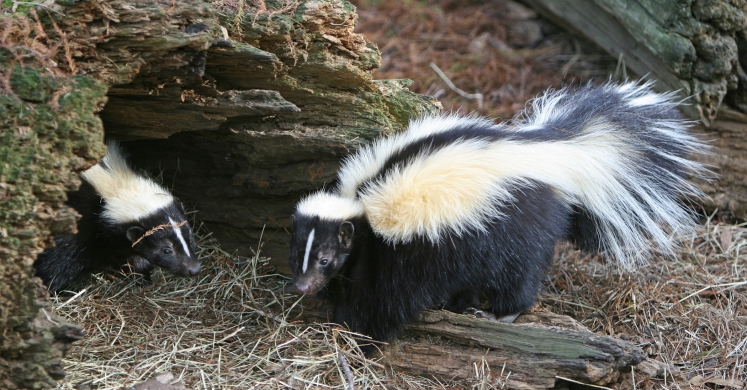Blog

#bioPGH Blog: The Striped and Stinky Style
 A resource of Biophilia: Pittsburgh, #bioPGH is a weekly blog and social media series that aims to encourage both children and adults to reconnect with nature and enjoy what each of our distinctive seasons has to offer.
A resource of Biophilia: Pittsburgh, #bioPGH is a weekly blog and social media series that aims to encourage both children and adults to reconnect with nature and enjoy what each of our distinctive seasons has to offer.
With the glorious spring weather finally here, you may have noticed that a variety of wildlife have poked out from their winter hide-outs and are active again. One such animal who was dormant over most the winter is our stinky little friend the skunk. We may wrinkle our nose at the mere mention of them, but in some way, we have always been fascinated by skunks! Native American legends featured them in stories as clever tricksters, cautionary tales of fallen vanity, defeated warriors, or playful creatures; and how many of us as children were familiar with the cartoons Flower and Pepe Le Pew? From the big screen to the backyards, here in Western Pennsylvania, we are most likely to see (or smell) the striped skunk, with its classic black and white motif. Let’s hold our noses and learn a bit more, shall we?
Skunks can live in a variety of habitat types, from forests to rural pastures to city parks, and their omnivorous diet are as varied as the homes in which they reside. Their diverse palate ranges from insects to fruits to small rodents and snakes! Though their homes and diets may vary, skunks are uniform in their solitary, nocturnal lifestyle. They prefer to stay out of sight, even with their defensive musk; but during February and March, they make an exception to the solo life for breeding season. The primary predators that skunks have to worry about are great horned owls. Since these birds of prey have a limited sense of smell, the musk won’t deter them from making a meal out of a skunk.
Whether owls ignore it or not, skunks are most famous for that musk! Skunks produce their musk in little glands around their anus, and when they spray, little muscles around gland help eject the musk. Lucky for us, skunks will try to intimidate before they resort to spraying. When threatened, skunks first perform a little warning dance, which can include foot-stamping, turning circles, or even performing hand stands! If you aren’t running by then, though, it’s probably too late. Skunks can directly spray their musk up to fifteen feet, and the smell can waft much further. (Depending on weather conditions, humans can detect the scent over a mile away.)
In what seems to be a rude practical joke of nature, though, skunk musk actually packs a double-punch. The primary scent that we notice comes from a group of chemicals called thiols. Skunk musk contains a blend of different chemicals called thiols, and we smell them immediately. However, if you’ve ever bathed a skunk-sprayed dog and noticed that he seemed to smell worse after the bath, that’s because some of the chemical compounds in musk (thiolacetates) are activated by water.
If you do get sprayed by a skunk, though, the fabled tomato juice bath won’t help. The most effective options seem to a detergent meant to clean grease, like dish soap, and a mix of diluted hydrogen peroxide and baking soda. The detergent will break down the oils present in the musk, and the peroxide and baking soda will break up the thiol molecules. (Do be aware, though, that the peroxide can bleach hair, fur, and clothes!)
However, it’s important to remember that skunks don’t want to spray you. They carry 5-6 “sprays” by default, but if they deplete their supply, it can take them up to ten days to generate enough to spray again, during which time they are defenseless. As with most wildlife, if you don’t bother them, they won’t bother you.
Now for a very important question: have you ever heard the sound a baby skunk makes?
Connecting to the Outdoors Tip: In the next few weeks, female skunks will start having their litters in well-hidden little dens. If by some chance you ever do spy a young skunk, it's best to let it alone - they can still produce musk and the young of the year are more likely to use it!
Continue the Conversation: Share your nature discoveries with our community by posting to Twitter and Instagram with hashtag #bioPGH, and R.S.V.P. to attend our next Biophilia: Pittsburgh meeting.
References
PBS Gross Science: The Chemistry of Skunk Spray
USFWS Clark River: Striped Skunk
USFWS Cold Springs: Striped Skunk
PA Game Commission: Striped Skunk
TAMU Nature Tourism: What You Don’t Know About Skunks
Photos: Cover, Tom Friedel, CC-BY-3.0; Header, Pexels C0

